Facies Analysis and Sedimentary Architecture of Hybrid Event Beds in Submarine Lobes: Insights from the Crocker Fan, NW Borneo, Malaysia
Abstract
:1. Introduction
2. Geological Settings
3. Materials and Methods
3.1. Data and Fieldwork
3.2. Hybrid Bed Facies
3.3. Lobe Architecture
4. Results and Interpretations
4.1. Hybrid Bed Facies in Proximal to Distal Lobes
4.1.1. Proximal Lobes
4.1.2. Medial Lobes
4.1.3. Distal Lobes
4.2. Hybrid Bed Facies in Frontal and Lateral Lobes
4.2.1. Frontal Lobes
4.2.2. Lateral Lobes
4.3. Hybrid Bed Facies in Lobe Progradation
5. Discussion
5.1. Lithological Heterogenerities in Hybrid Beds and Reservoir Potential
5.2. Distribution of Hybrid Bed Facies
5.3. Geodynamic Evolution of Hybrid Beds
5.4. Hybrid Event Beds in Sand-Rich Deep-Marine Fan
6. Conclusions
- 1.
- The sedimentary facies of hybrid events exhibit rapid internal variability in geometry and divisions, characteristic of hybrid event beds in a deep-water system. These variations are typically developed due to numerous forms of basin configuration and transitional flow processes in a depositional environment.
- 2.
- It is quite possible that deep-marine sedimentary succession may be devoid of any hybrid event bed facies, especially in the most proximal and the most distal parts of lobes, where the chances of flow transformation are minimum and consequently, no hybrid event beds are formed in these domains.
- 3.
- Occasionally, the proximal lobes have multimeter vertical thickness with sandy hybrid event bed facies (H1 and H2), medial lobes have complete sedimentary facies succession of hybrid event bed sequence (H1 to H5), while the distal lobes predominantly contain only muddy hybrid event beds (H3 and H5) ranging in total thickness from 0.6 to 1.5 m of a complete hybrid event bed sequence.
- 4.
- Frontal lobes are formed of sediments with variable facies distribution including H1 and H3 in the innermost axial area, while they include a more-developed chaotic division (H3) away from the proximal domain.
- 5.
- The development of hybrid event beds is dependent on flow transformation and the zone of transition in a flow event. The gradual transformation of flow favors the deposition of a hybrid sequence while abrupt changes in flow may diminish the chances of hybrid bed deposition.
- 6.
- Deep-water sedimentary deposition commonly comprises a fan lobe system and is occasionally associated with hybrid bed facies. Muddy sandstone and clay-rich hybrid event bed facies adversely affect the reservoir potential of sandy lobe intervals. This will significantly hinder the pore network and connectivity for lateral and vertical migration of fluids from reservoirs.
Author Contributions
Funding
Institutional Review Board Statement
Informed Consent Statement
Data Availability Statement
Acknowledgments
Conflicts of Interest
References
- Li, S.; Zhu, X.; Li, S.; Gong, C.; Pan, R.; Chen, H. Trigger mechanisms of gravity flow deposits in the Lower Cretaceous lacustrine rift basin of Lingshan Island, Eastern China. Cretac. Res. 2020, 107, 104269. [Google Scholar] [CrossRef]
- Talling, P.J.; Masson, D.G.; Sumner, E.J.; Malgesini, G. Subaqueous sediment density flows: Depositional processes and deposit types. Sedimentology 2012, 59, 1937–2003. [Google Scholar] [CrossRef]
- Imran, Q.S.; Siddiqui, N.A.; Latif, A.H.A.; Bashir, Y.; Ali, A.A.A.S.; Jamil, M. Integrated well data and 3D seismic inversion study for reservoir delineation and description. Bull. Geol. Soc. Malays. 2020, 70, 209–220. [Google Scholar] [CrossRef]
- Imran, Q.S.; Siddiqui, N.A.; Latiff, A.H.; Bashir, Y.; Khan, M.; Qureshi, K.; Al-Masgari, A.A.; Ahmed, N.; Jamil, M. Automated Fault Detection and Extraction under Gas Chimneys Using Hybrid Discontinuity Attributes. Appl. Sci. 2021, 11, 7218. [Google Scholar] [CrossRef]
- Usman, M.; Siddiqui, N.A.; Garzanti, E.; Jamil, M.; Imran, Q.S.; Ahmed, L. 3-D seismic interpretation of stratigraphic and structural features in the Upper Jurassic to Lower Cretaceous sequence of the Gullfaks Field, Norwegian North Sea: A case study of reservoir development. Energy Geosci. 2021. [Google Scholar] [CrossRef]
- Banerjee, A.; Ahmed Salim, A.M. Stratigraphic evolution of deep-water Dangerous Grounds in the South China Sea, NW Sabah Platform Region, Malaysia. J. Pet. Sci. Eng. 2021, 201, 108434. [Google Scholar] [CrossRef]
- Cullis, S.; Patacci, M.; Colombera, L.; Bührig, L.; McCaffrey, W.D. A database solution for the quantitative characterisation and comparison of deep-marine siliciclastic depositional systems. Mar. Pet. Geol. 2019, 102, 321–339. [Google Scholar] [CrossRef]
- Galy, V.; France-Lanord, C.; Beyssac, O.; Faure, P.; Kudrass, H.; Palhol, F. Efficient organic carbon burial in the Bengal fan sustained by the Himalayan erosional system. Nature 2007, 450, 407–410. [Google Scholar] [CrossRef]
- Hunt, J.E.; Wynn, R.B.; Masson, D.G.; Talling, P.J.; Teagle, D.A.H. Sedimentological and geochemical evidence for multistage failure of volcanic island landslides: A case study from Icod landslide on north Tenerife, Canary Islands. Geochem. Geophys. Geosyst. 2011, 12. [Google Scholar] [CrossRef]
- Zhao, Y.; Wang, H.; Yan, D.; Jiang, P.; Chen, S.; Zhou, J.; Ma, J.; Qin, C.; He, J.; Zhao, Y. Sedimentary characteristics and model of gravity flows in the eocene Liushagang Formation in Weixi’nan depression, South China Sea. J. Pet. Sci. Eng. 2020, 190, 107082. [Google Scholar] [CrossRef]
- Dodd, T.J.H.; McCarthy, D.J.; Richards, P.C. A depositional model for deep-lacustrine, partially confined, turbidite fans: Early Cretaceous, North Falkland Basin. Sedimentology 2019, 66, 53–80. [Google Scholar] [CrossRef]
- Southern, S.J.; Kane, I.A.; Warchoł, M.J.; Porten, K.W.; McCaffrey, W.D. Hybrid event beds dominated by transitional-flow facies: Character, distribution and significance in the Maastrichtian Springar Formation, north-west Vøring Basin, Norwegian Sea. Sedimentology 2017, 64, 747–776. [Google Scholar] [CrossRef] [Green Version]
- Talling, P.J.; Wynn, R.B.; Masson, D.G.; Frenz, M.; Cronin, B.T.; Schiebel, R.; Akhmetzhanov, A.M.; Dallmeier-Tiessen, S.; Benetti, S.; Weaver, P.P.E.; et al. Onset of submarine debris flow deposition far from original giant landslide. Nature 2007, 450, 541–544. [Google Scholar] [CrossRef]
- Stow, D.; Smillie, Z. Distinguishing between Deep-Water Sediment Facies: Turbidites, Contourites and Hemipelagites. Geosciences 2020, 10, 68. [Google Scholar] [CrossRef] [Green Version]
- Sohn, Y.K. Depositional Processes of Submarine Debris Flows in the Miocene Fan Deltas, Pohang Basin, SE Korea with Special Reference to Flow Transformation. J. Sediment. Res. 2000, 70, 491–503. [Google Scholar] [CrossRef]
- Haughton, P.D.W.; Barker, S.P.; McCaffrey, W.D. ‘Linked’ debrites in sand-rich turbidite systems—Origin and significance. Sedimentology 2003, 50, 459–482. [Google Scholar] [CrossRef]
- Talling, P.J.; Amy, L.A.; Wynn, R.B.; Peakall, J.; Robinson, M. Beds comprising debrite sandwiched within co-genetic turbidite: Origin and widespread occurrence in distal depositional environments. Sedimentology 2004, 51, 163–194. [Google Scholar] [CrossRef]
- Hodgson, D.M. Distribution and origin of hybrid beds in sand-rich submarine fans of the Tanqua depocentre, Karoo Basin, South Africa. Mar. Pet. Geol. 2009, 26, 1940–1956. [Google Scholar] [CrossRef]
- Haughton, P.; Davis, C.; McCaffrey, W.; Barker, S. Hybrid sediment gravity flow deposits—Classification, origin and significance. Mar. Pet. Geol. 2009, 26, 1900–1918. [Google Scholar] [CrossRef]
- Talling, P.J.; Malgesini, G.; Sumner, E.J.; Amy, L.A.; Felletti, F.; Blackbourn, G.; Nutt, C.; Wilcox, C.; Harding, I.C.; Akbari, S. Planform geometry, stacking pattern, and extrabasinal origin of low strength and intermediate strength cohesive debris flow deposits in the Marnoso-arenacea Formation, Italy. Geosphere 2012, 8, 1207–1230. [Google Scholar] [CrossRef]
- Kane, I.A.; Pontén, A.S.M. Submarine transitional flow deposits in the Paleogene Gulf of Mexico. Geology 2012, 40, 1119–1122. [Google Scholar] [CrossRef]
- Terlaky, V.; Arnott, R.W.C. Matrix-rich and associated matrix-poor sandstones: Avulsion splays in slope and basin-floor strata. Sedimentology 2014, 61, 1175–1197. [Google Scholar] [CrossRef]
- Koo, W.M.; Mohrig, D.; Buttles, J.; Sturmer, D.; Pontén, A.; Hess, T. Sand–mud couplets deposited by spontaneous remobilization of subaqueous transitional flows. Sedimentology 2020, 67, 78–95. [Google Scholar] [CrossRef]
- Shanmugam, G. Deep-Water Processes and Deposits. In Encyclopedia of Geology; Elsevier: Amsterdam, The Netherlands, 2020. [Google Scholar]
- Lowe, D.R.; Guy, M. Slurry-flow deposits in the Britannia Formation (Lower Cretaceous), North Sea: A new perspective on the turbidity current and debris flow problem. Sedimentology 2000, 47, 31–70. [Google Scholar] [CrossRef]
- Baas, J.H.; Best, J.L.; Peakall, J. Depositional processes, bedform development and hybrid bed formation in rapidly decelerated cohesive (mud–sand) sediment flows. Sedimentology 2011, 58, 1953–1987. [Google Scholar] [CrossRef] [Green Version]
- Doughty-Jones, G.; Mayall, M.; Lonergan, L. Stratigraphy, facies, and evolution of deep-water lobe complexes within a salt-controlled intraslope minibasin. AAPG Bull. 2017, 101, 1879–1904. [Google Scholar] [CrossRef]
- Al-Masgari, A.A.; Elsaadany, M.; Siddiqui, N.A.; Latiff, A.H.; Bakar, A.A.; Elkurdy, S.; Hermana, M.; Babikir, I.; Imran, Q.S.; Adeleke, T. Geomorphological Geometries and High-Resolution Seismic Sequence Stratigraphy of Malay Basin’s Fluvial Succession. Appl. Sci. 2021, 11, 5156. [Google Scholar] [CrossRef]
- Baker, M.L.; Baas, J.H. Mixed sand–mud bedforms produced by transient turbulent flows in the fringe of submarine fans: Indicators of flow transformation. Sedimentology 2020, 67, 2645–2671. [Google Scholar] [CrossRef]
- Fonnesu, M.; Haughton, P.; Felletti, F.; McCaffrey, W. Short length-scale variability of hybrid event beds and its applied significance. Mar. Pet. Geol. 2015, 67, 583–603. [Google Scholar] [CrossRef] [Green Version]
- Patacci, M.; Marini, M.; Felletti, F.; Di Giulio, A.; Setti, M.; McCaffrey, W. Origin of mud in turbidites and hybrid event beds: Insight from ponded mudstone caps of the Castagnola turbidite system (north-west Italy). Sedimentology 2020, 67, 2625–2644. [Google Scholar] [CrossRef]
- Fonnesu, M.; Felletti, F.; Haughton, P.D.W.; Patacci, M.; McCaffrey, W.D. Hybrid event bed character and distribution linked to turbidite system sub-environments: The North Apennine Gottero Sandstone (north-west Italy). Sedimentology 2018, 65, 151–190. [Google Scholar] [CrossRef] [Green Version]
- Spychala, Y.T.; Hodgson, D.M.; Prélat, A.; Kane, I.A.; Flint, S.S.; Mountney, N.P. Frontal and Lateral Submarine Lobe Fringes: Comparing Sedimentary Facies, Architecture and Flow Processes. J. Sediment. Res. 2017, 87, 75–96. [Google Scholar] [CrossRef]
- Marini, M.; Milli, S.; Ravnås, R.; Moscatelli, M. A comparative study of confined vs. semi-confined turbidite lobes from the Lower Messinian Laga Basin (Central Apennines, Italy): Implications for assessment of reservoir architecture. Mar. Pet. Geol. 2015, 63, 142–165. [Google Scholar] [CrossRef]
- Talling, P.J. Hybrid submarine flows comprising turbidity current and cohesive debris flow: Deposits, theoretical and experimental analyses, and generalized models. Geosphere 2013, 9, 460–488. [Google Scholar] [CrossRef] [Green Version]
- Yang, T.; Cao, Y.; Friis, H.; Liu, K.; Wang, Y. Origin and evolution processes of hybrid event beds in the Lower Cretaceous of the Lingshan Island, Eastern China. Aust. J. Earth Sci. 2018, 65, 517–534. [Google Scholar] [CrossRef]
- Fonnesu, M.; Patacci, M.; Haughton, P.D.W.; Felletti, F.; McCaffrey, W.D. Hybrid Event Beds Generated By Local Substrate Delamination on A Confined-Basin Floor. J. Sediment. Res. 2016, 86, 929–943. [Google Scholar] [CrossRef]
- Mueller, P.; Patacci, M.; Di Giulio, A. Hybrid event beds in the proximal to distal extensive lobe domain of the coarse-grained and sand-rich Bordighera turbidite system (NW Italy). Mar. Pet. Geol. 2017, 86, 908–931. [Google Scholar] [CrossRef]
- Pierce, C.S.; Haughton, P.D.W.; Shannon, P.M.; Pulham, A.J.; Barker, S.P.; Martinsen, O.J. Variable character and diverse origin of hybrid event beds in a sandy submarine fan system, Pennsylvanian Ross Sandstone Formation, western Ireland. Sedimentology 2018, 65, 952–992. [Google Scholar] [CrossRef]
- Kane, I.A.; Pontén, A.S.M.; Vangdal, B.; Eggenhuisen, J.T.; Hodgson, D.M.; Spychala, Y.T. The stratigraphic record and processes of turbidity current transformation across deep-marine lobes. Sedimentology 2017, 64, 1236–1273. [Google Scholar] [CrossRef] [Green Version]
- Spychala, Y.T.; Hodgson, D.M.; Lee, D.R. Autogenic controls on hybrid bed distribution in submarine lobe complexes. Mar. Pet. Geol. 2017, 88, 1078–1093. [Google Scholar] [CrossRef] [Green Version]
- Kuswandaru, G.Y.; Amir Hassan, M.H.; Matenco, L.C.; Taib, N.I.; Mustapha, K.A. Turbidite, debrite, and hybrid event beds in submarine lobe deposits of the Palaeocene to middle Eocene Kapit and Pelagus members, Belaga Formation, Sarawak, Malaysia. Geol. J. 2019, 54, 3421–3437. [Google Scholar] [CrossRef]
- Hofstra, M.; Pontén, A.S.M.; Peakall, J.; Flint, S.S.; Nair, K.N.; Hodgson, D.M. The impact of fine-scale reservoir geometries on streamline flow patterns in submarine lobe deposits using outcrop analogues from the Karoo Basin. Pet. Geosci. 2016, 23, 159–176. [Google Scholar] [CrossRef]
- Porten, K.W.; Kane, I.A.; Warchoł, M.J.; Southern, S.J. A Sedimentological Process-Based Approach to Depositional Reservoir Quality of Deep-Marine Sandstones: An Example From the Springar Formation, Northwestern Vøring Basin, Norwegian Sea. J. Sediment. Res. 2016, 86, 1269–1286. [Google Scholar] [CrossRef] [Green Version]
- Zhang, L.; Pan, M.; Wang, H. Deepwater Turbidite Lobe Deposits: A Review of the Research Frontiers. Acta Geol. Sin. Engl. Ed. 2017, 91, 283–300. [Google Scholar] [CrossRef]
- Jackson, C.A.L.; Zakaria, A.A.; Johnson, H.D.; Tongkul, F.; Crevello, P.D. Sedimentology, stratigraphic occurrence and origin of linked debrites in the West Crocker Formation (Oligo-Miocene), Sabah, NW Borneo. Mar. Pet. Geol. 2009, 26, 1957–1973. [Google Scholar] [CrossRef]
- Zakaria, A.A.; Johnson, H.D.; Jackson, C.A.-L.; Tongkul, F. Sedimentary facies analysis and depositional model of the Palaeogene West Crocker submarine fan system, NW Borneo. J. Asian Earth Sci. 2013, 76, 283–300. [Google Scholar] [CrossRef]
- Bell, D.; Stevenson, C.J.; Kane, I.A.; Hodgson, D.M.; Poyatos-Moré, M. Topographic Controls On the Development of Contemporaneous but Contrasting Basin-Floor Depositional Architectures. J. Sediment. Res. 2018, 88, 1166–1189. [Google Scholar] [CrossRef] [Green Version]
- Brooks, H.L.; Hodgson, D.M.; Brunt, R.L.; Peakall, J.; Hofstra, M.; Flint, S.S. Deep-water channel-lobe transition zone dynamics: Processes and depositional architecture, an example from the Karoo Basin, South Africa. GSA Bull. 2018, 130, 1723–1746. [Google Scholar] [CrossRef]
- Soutter, E.L.; Kane, I.A.; Fuhrmann, A.; Cumberpatch, Z.A.; Huuse, M. The stratigraphic evolution of onlap in siliciclastic deep-water systems: Autogenic modulation of allogenic signals. J. Sediment. Res. 2019, 89, 890–917. [Google Scholar] [CrossRef] [Green Version]
- Hall, R.; van Hattum, M.W.A.; Spakman, W. Impact of India-Asia collision on SE Asia: The record in Borneo. Tectonophysics 2008, 451, 366–389. [Google Scholar] [CrossRef]
- Siddiqui, N.A.; Ramkumar, M.; Rahman, A.H.A.; Mathew, M.J.; Santosh, M.; Sum, C.W.; Menier, D. High resolution facies architecture and digital outcrop modeling of the Sandakan formation sandstone reservoir, Borneo: Implications for reservoir characterization and flow simulation. Geosci. Front. 2019, 10, 957–971. [Google Scholar] [CrossRef]
- Usman, M.; Siddiqui, N.A.; Mathew, M.; Zhang, S.; El-Ghali, M.A.K.; Ramkumar, M.; Jamil, M.; Zhang, Y. Linking the influence of diagenetic properties and clay texture on reservoir quality in sandstones from NW Borneo. Mar. Pet. Geol. 2020, 120, 104509. [Google Scholar] [CrossRef]
- Usman, M.; Siddiqui, N.A.; Zhang, S.-Q.; Mathew, M.J.; Zhang, Y.-X.; Jamil, M.; Liu, X.-L.; Ahmed, N. 3D Geo-Cellular Static Virtual Outcrop Model and its Implications for Reservoir Petro-physical Characteristics and Heterogeneities. Pet. Sci. 2021. [Google Scholar] [CrossRef]
- Ahmed, N.; Siddiqui, N.A.; Ramasamy, N.; Ramkumar, M.; Jamil, M.; Usman, M.; Sajid, Z.; Rahman, A.H.B.A. Geochemistry of Eocene Bawang Member turbidites of the Belaga Formation, Borneo: Implications for provenance, palaeoweathering, and tectonic setting. Geol. J. 2021, 56, 2477–2499. [Google Scholar] [CrossRef]
- Sheikh, N.A.; Jamil, M.; Ling Chuan Ching, D.; Khan, I.; Usman, M.; Sooppy Nisar, K. A generalized model for quantitative analysis of sediments loss: A Caputo time fractional model. J. King Saud Univ. Sci. 2021, 33, 101179. [Google Scholar] [CrossRef]
- Hall, R. Contraction and extension in northern Borneo driven by subduction rollback. J. Asian Earth Sci. 2013, 76, 399–411. [Google Scholar] [CrossRef]
- Mathew, M.J.; Menier, D.; Siddiqui, N.; Ramkumar, M.; Santosh, M.; Kumar, S.; Hassaan, M. Drainage basin and topographic analysis of a tropical landscape: Insights into surface and tectonic processes in northern Borneo. J. Asian Earth Sci. 2016, 124, 14–27. [Google Scholar] [CrossRef]
- Siddiqui, N.A.; Mathew, M.J.; Ramkumar, M.; Sautter, B.; Usman, M.; Abdul Rahman, A.H.; El-Ghali, M.A.K.; Menier, D.; Shiqi, Z.; Sum, C.W. Sedimentological characterization, petrophysical properties and reservoir quality assessment of the onshore Sandakan Formation, Borneo. J. Pet. Sci. Eng. 2020, 186, 106771. [Google Scholar] [CrossRef]
- Siddiqui, N.A.; Rahman, A.H.A.; Sum, C.W.; Mathew, M.J.; Hassaan, M.; Menier, D. Generic hierarchy of sandstone facies quality and static connectivity: An example from the Middle-Late Miocene Miri Formation, Sarawak Basin, Borneo. Arab. J. Geosci. 2017, 10, 237. [Google Scholar] [CrossRef]
- Ahmed, N.; Siddiqui, N.A.; Rahman, A.H.B.A.; Jamil, M.; Usman, M.; Sajid, Z.; Kamal Zaidi, F. Evaluation of hydrocarbon source rock potential: Deep marine shales of Belaga Formation of Late Cretaceous-Late Eocene, Sarawak, Malaysia. J. King Saud Univ. Sci. 2021, 33, 101268. [Google Scholar] [CrossRef]
- Hall, R. Cenozoic geological and plate tectonic evolution of SE Asia and the SW Pacific: Computer-based reconstructions, model and animations. J. Asian Earth Sci. 2002, 20, 353–431. [Google Scholar] [CrossRef]
- Jamil, M.; Rahman, A.H.A.; Siddiqui, N.A.; Ahmed, N. Deep marine Paleogene sedimentary sequence of West Sabah: Contemporary opinions and ambiguities. War. Geol. 2019, 45, 198–200. [Google Scholar]
- Jamil, M.; Rahman, A.H.A.; Siddiqui, N.A.; Ibrahim, N.A.; Ahmed, N. A contemporary review of sedimentological and stratigraphic framework of the Late Paleogene deep marine sedimentary successions of West Sabah, North-West Borneo. Bull. Geol. Soc. Malays. 2020, 69, 53–65. [Google Scholar] [CrossRef]
- Clennell, B. Far-field and gravity tectonics in Miocene basins of Sabah, Malaysia. Geol. Soc. Lond. Spec. Publ. 1996, 106, 307–320. [Google Scholar] [CrossRef]
- Cullen, A.B.; Zechmeister, M.S.; Elmore, R.D.; Pannalal, S.J. Paleomagnetism of the Crocker Formation, northwest Borneo: Implications for late Cenozoic tectonics. Geosphere 2012, 8, 1146–1169. [Google Scholar] [CrossRef] [Green Version]
- Wang, P.; Li, S.; Guo, L.; Jiang, S.; Somerville, I.; Zhao, S.; Zhu, B.; Chen, J.; Dai, L.; Suo, Y. Mesozoic and Cenozoic accretionary orogenic processes in Borneo and their mechanisms. Geol. J. 2016, 51, 464–489. [Google Scholar] [CrossRef]
- Jamil, M.; Siddiqui, N.A.; Umar, M.; Usman, M.; Ahmed, N.; Rahman, A.H.A.; Zaidi, F.K. Aseismic and seismic impact on development of soft-sediment deformation structures in deep-marine sand-shaly Crocker fan in Sabah, NW Borneo. J. King Saud Univ. Sci. 2021, 33, 101522. [Google Scholar] [CrossRef]
- Lambiase, J.J.; Tzong, T.Y.; William, A.G.; Bidgood, M.D.; Brenac, P.; Cullen, A.B. The West Crocker formation of northwest Borneo: A Paleogene accretionary prism. Spec. Pap. Geol. Soc. Am. 2008, 436, 171–184. [Google Scholar]
- van Hattum, M.W.A.; Hall, R.; Pickard, A.L.; Nichols, G.J. Provenance and geochronology of Cenozoic sandstones of northern Borneo. J. Asian Earth Sci. 2013, 76, 266–282. [Google Scholar] [CrossRef]
- Abdullah, W.H.; Togunwa, O.S.; Makeen, Y.M.; Hakimi, M.H.; Mustapha, K.A.; Baharuddin, M.H.; Sia, S.-G.; Tongkul, F. Hydrocarbon source potential of Eocene-Miocene sequence of Western Sabah, Malaysia. Mar. Pet. Geol. 2017, 83, 345–361. [Google Scholar] [CrossRef]
- Madon, M. Deep-sea trace fossils in the West Crocker Formation, Sabah (Malaysia), and their palaeoenvironmental significance. Bull. Geol. Soc. Malays. 2021, 71, 23–46. [Google Scholar] [CrossRef]
- Usman, M.; Siddiqui, N.A.; Zhang, S.; Ramkumar, M.; Mathew, M.; Sautter, B.; Beg, M.A. Ichnofacies and sedimentary structures: A passive relationship with permeability of a sandstone reservoir from NW Borneo. J. Asian Earth Sci. 2020, 192, 103992. [Google Scholar] [CrossRef]
- Prélat, A.; Hodgson, D.M.; Flint, S.S. Evolution, architecture and hierarchy of distributary deep-water deposits: A high-resolution outcrop investigation from the Permian Karoo Basin, South Africa. Sedimentology 2009, 56, 2132–2154. [Google Scholar] [CrossRef]
- Shanmugam, G. The hyperpycnite problem. J. Palaeogeogr. 2018, 7, 6. [Google Scholar] [CrossRef] [Green Version]
- Brunt, R.L.; Di Celma, C.N.; Hodgson, D.M.; Flint, S.S.; Kavanagh, J.P.; van der Merwe, W.C. Driving a channel through a levee when the levee is high: An outcrop example of submarine down-dip entrenchment. Mar. Pet. Geol. 2013, 41, 134–145. [Google Scholar] [CrossRef]
- Groenenberg, R.M.; Hodgson, D.M.; Prelat, A.; Luthi, S.M.; Flint, S.S. Flow–deposit interaction in submarine lobes: Insights from outcrop observations and realizations of a process-based numerical model. J. Sediment. Res. 2010, 80, 252–267. [Google Scholar] [CrossRef] [Green Version]
- Zhang, L.-F.; Pan, M.; Li, Z.-L. 3D modeling of deepwater turbidite lobes: A review of the research status and progress. Pet. Sci. 2020, 17, 317–333. [Google Scholar] [CrossRef] [Green Version]
- Jamil, M.; Siddiqui, N.A.; Rahman, A.H.B.A.; Ibrahim, N.A.; Ismail, M.S.B.; Ahmed, N.; Usman, M.; Gul, Z.; Imran, Q.S. Facies Heterogeneity and Lobe Facies Multiscale Analysis of Deep-Marine Sand-Shale Complexity in the West Crocker Formation of Sabah Basin, NW Borneo. Appl. Sci. 2021, 11, 5513. [Google Scholar] [CrossRef]
- Davis, C.; Haughton, P.; McCaffrey, W.; Scott, E.; Hogg, N.; Kitching, D. Character and distribution of hybrid sediment gravity flow deposits from the outer Forties Fan, Palaeocene Central North Sea, UKCS. Mar. Pet. Geol. 2009, 26, 1919–1939. [Google Scholar] [CrossRef]
- Zhang, L.-F.; Dong, D.-Z. Thickening-upward cycles in deep-marine and deep-lacustrine turbidite lobes: Examples from the Clare Basin and the Ordos Basin. J. Palaeogeogr. 2020, 9, 1–16. [Google Scholar] [CrossRef] [Green Version]
- Southern, S.J.; Patacci, M.; Felletti, F.; McCaffrey, W.D. Influence of flow containment and substrate entrainment upon sandy hybrid event beds containing a co-genetic mud-clast-rich division. Sediment. Geol. 2015, 321, 105–122. [Google Scholar] [CrossRef] [Green Version]
- Lee, S.H.; Jung, W.-Y.; Bahk, J.J.; Gardner, J.M.; Kim, J.K.; Lee, S.H. Depositional features of co-genetic turbidite–debrite beds and possible mechanisms for their formation in distal lobated bodies beyond the base-of-slope, Ulleung Basin, East Sea (Japan Sea). Mar. Geol. 2013, 346, 124–140. [Google Scholar] [CrossRef]
- Giacomone, G.; Olariu, C.; Steel, R.; Shin, M. A coarse-grained basin floor turbidite system—the Jurassic Los Molles Formation, Neuquen Basin, Argentina. Sedimentology 2020, 67, 3809–3843. [Google Scholar] [CrossRef]
- Hussain, A.; Haughton, P.D.W.; Shannon, P.M.; Turner, J.N.; Pierce, C.S.; Obradors-Latre, A.; Barker, S.P.; Martinsen, O.J. High-resolution X-ray fluorescence profiling of hybrid event beds: Implications for sediment gravity flow behaviour and deposit structure. Sedimentology 2020, 67, 2850–2882. [Google Scholar] [CrossRef]
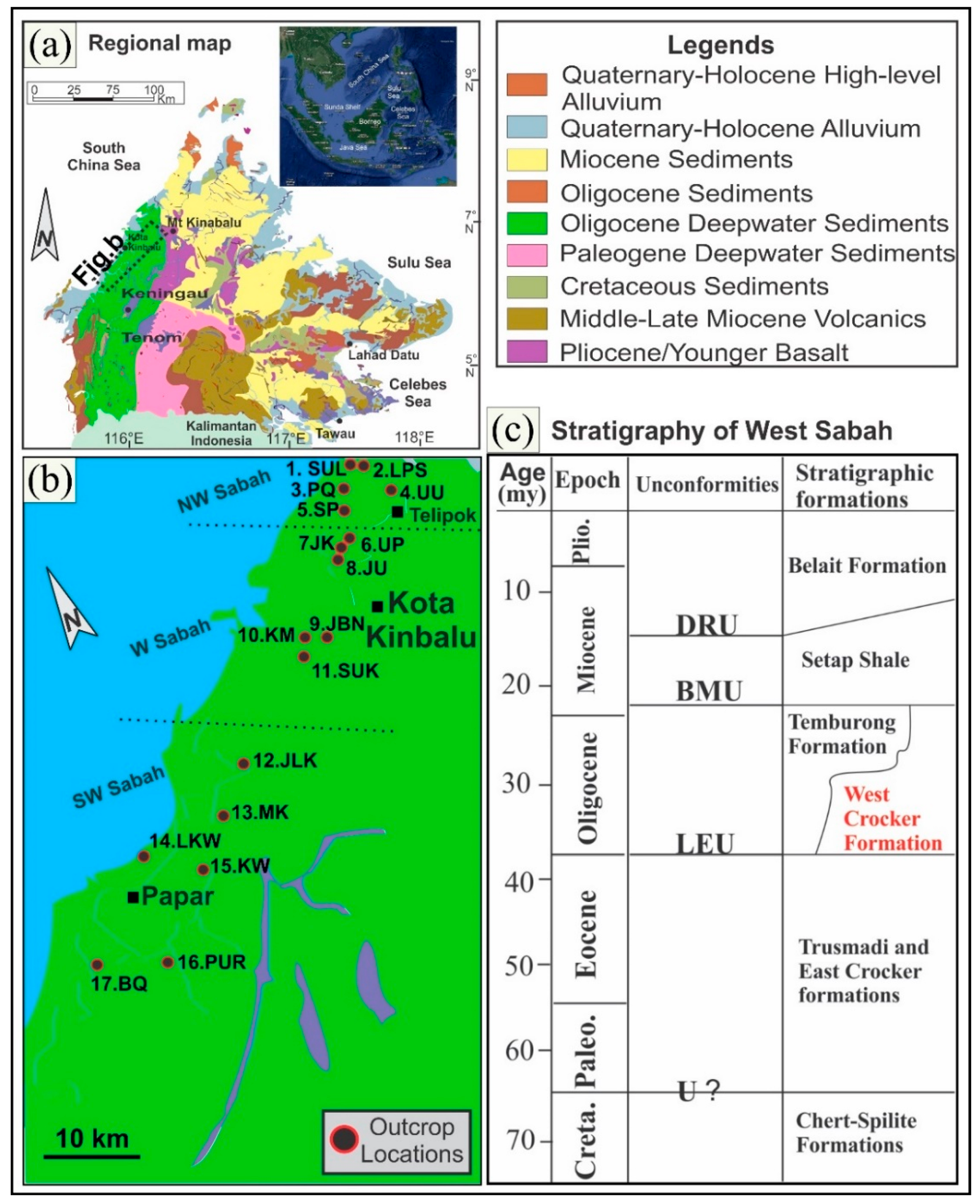
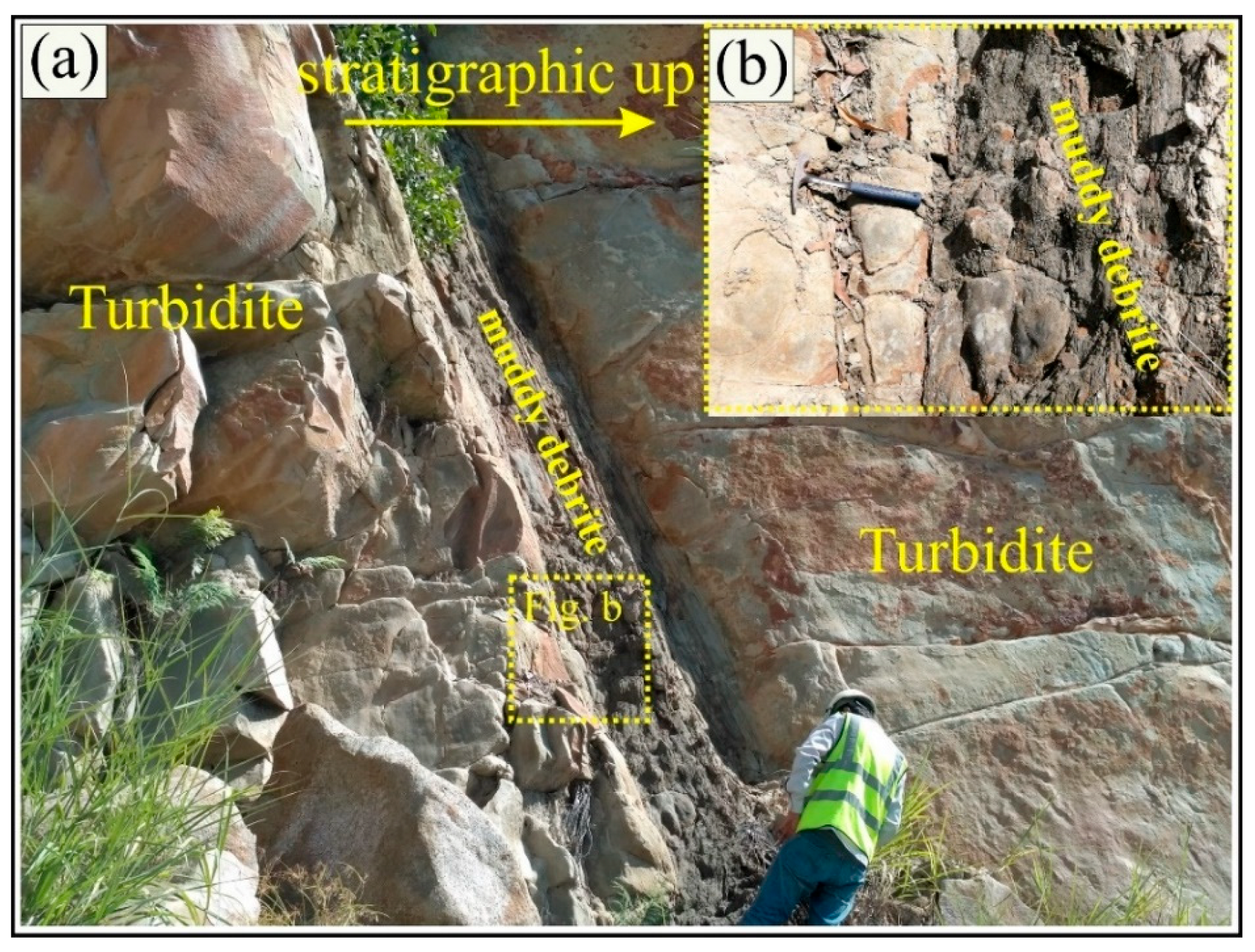
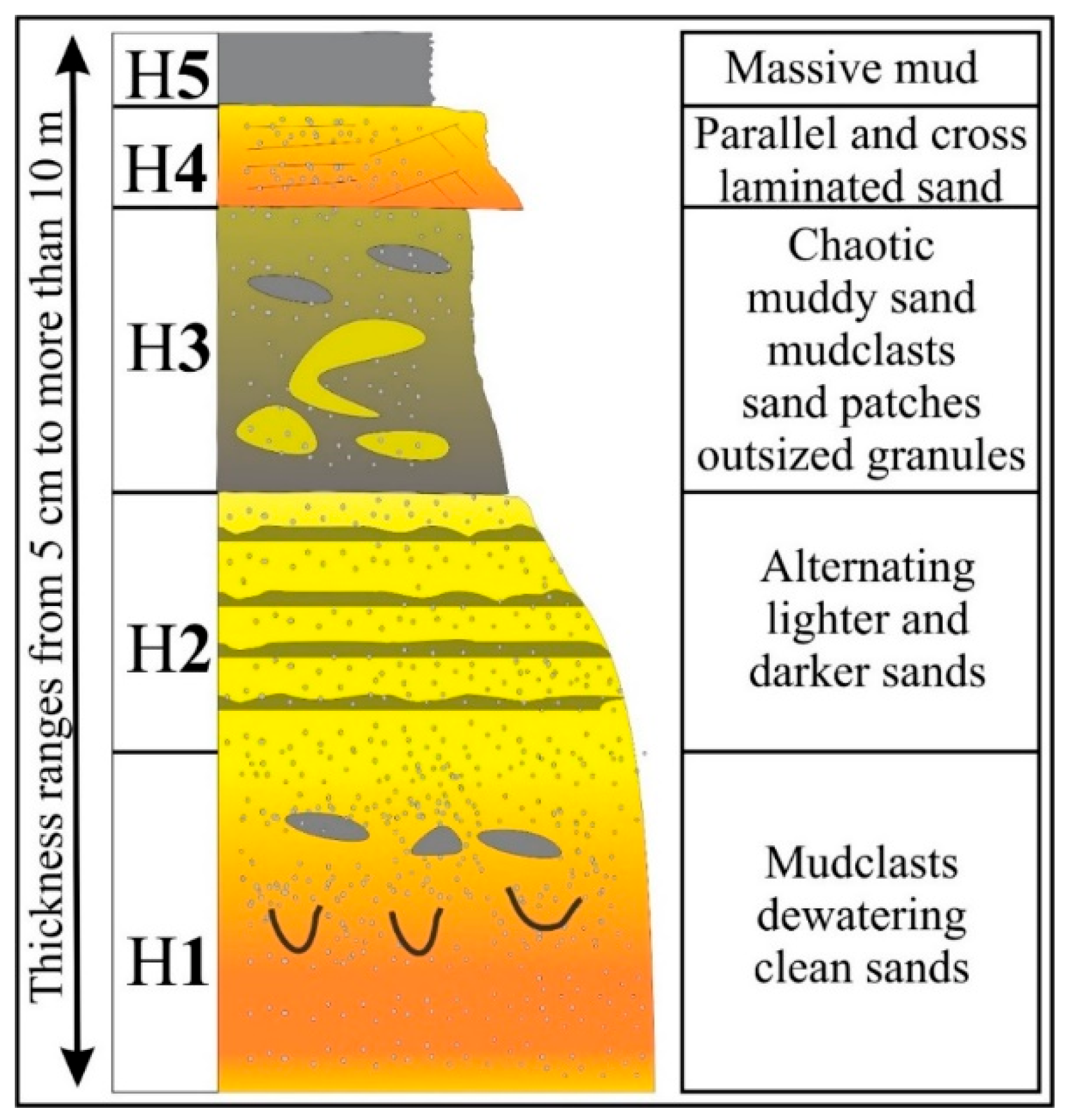
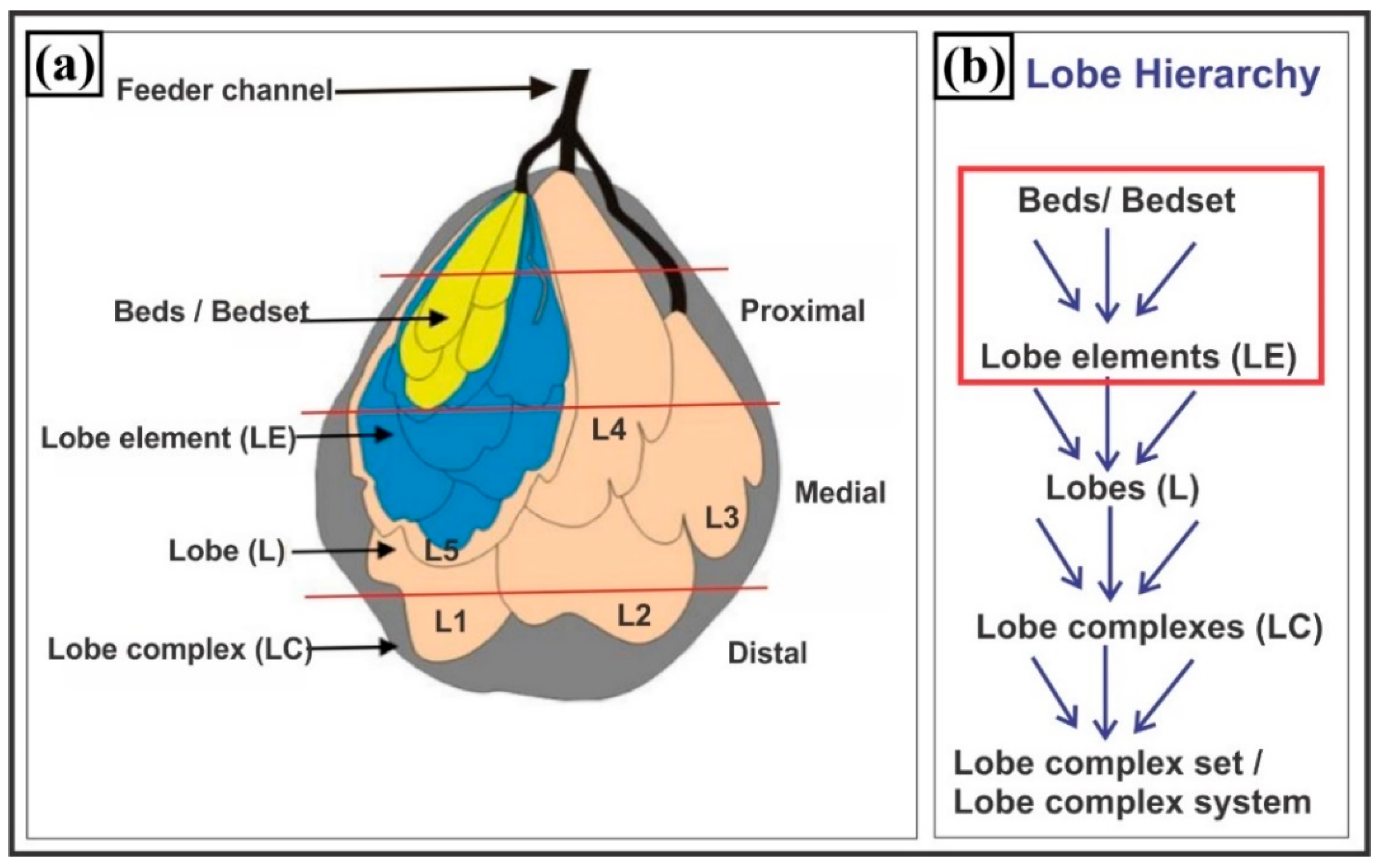
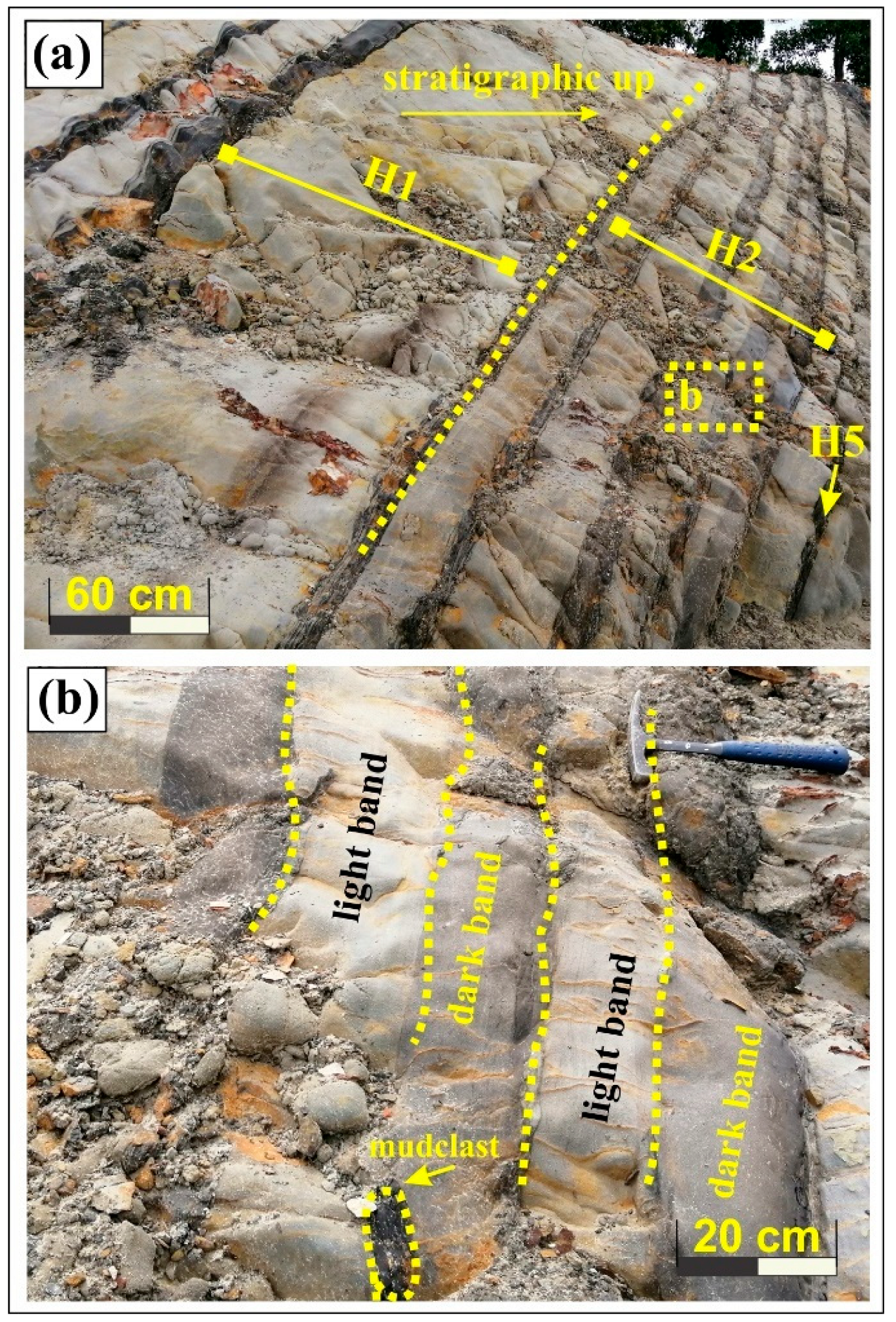
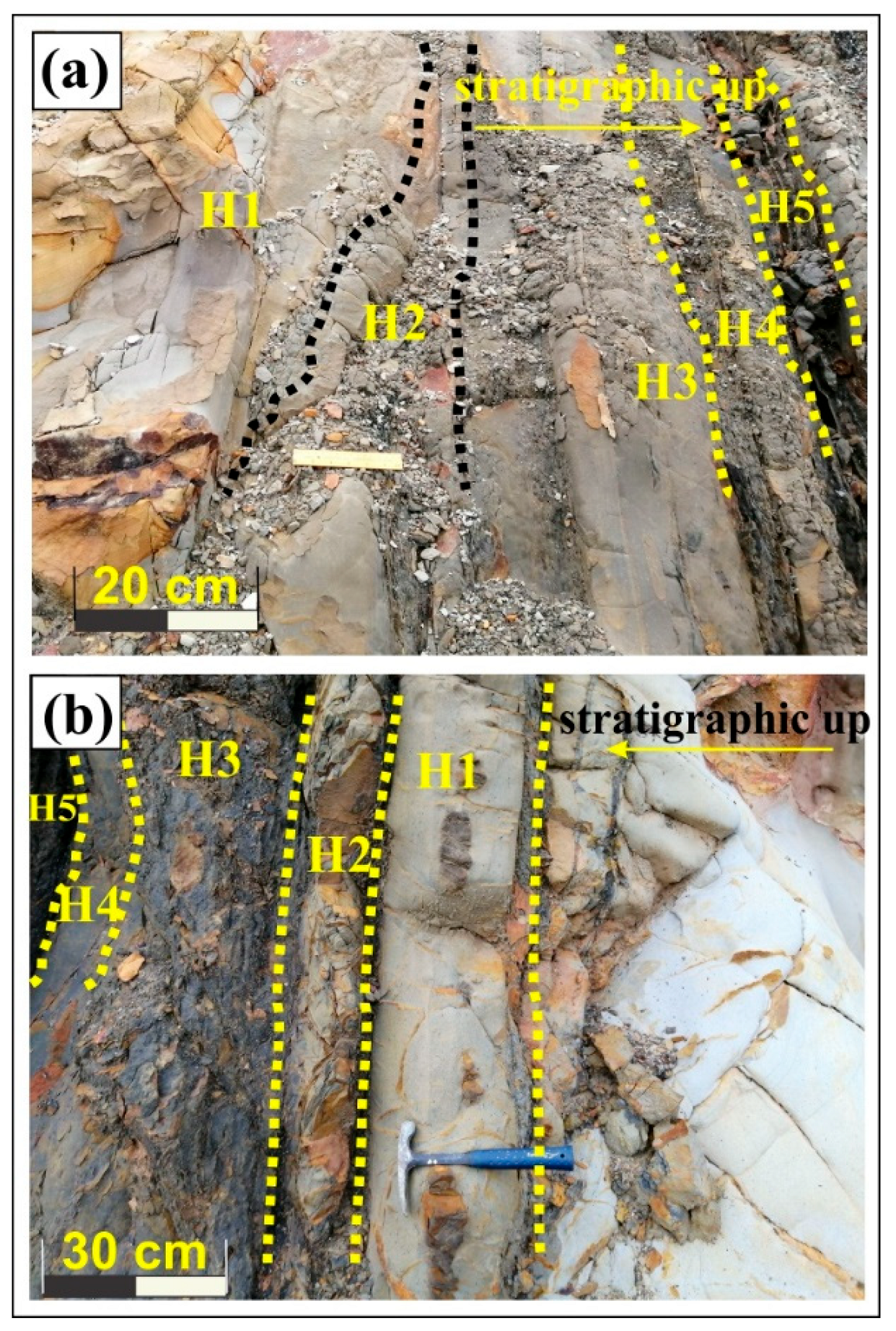

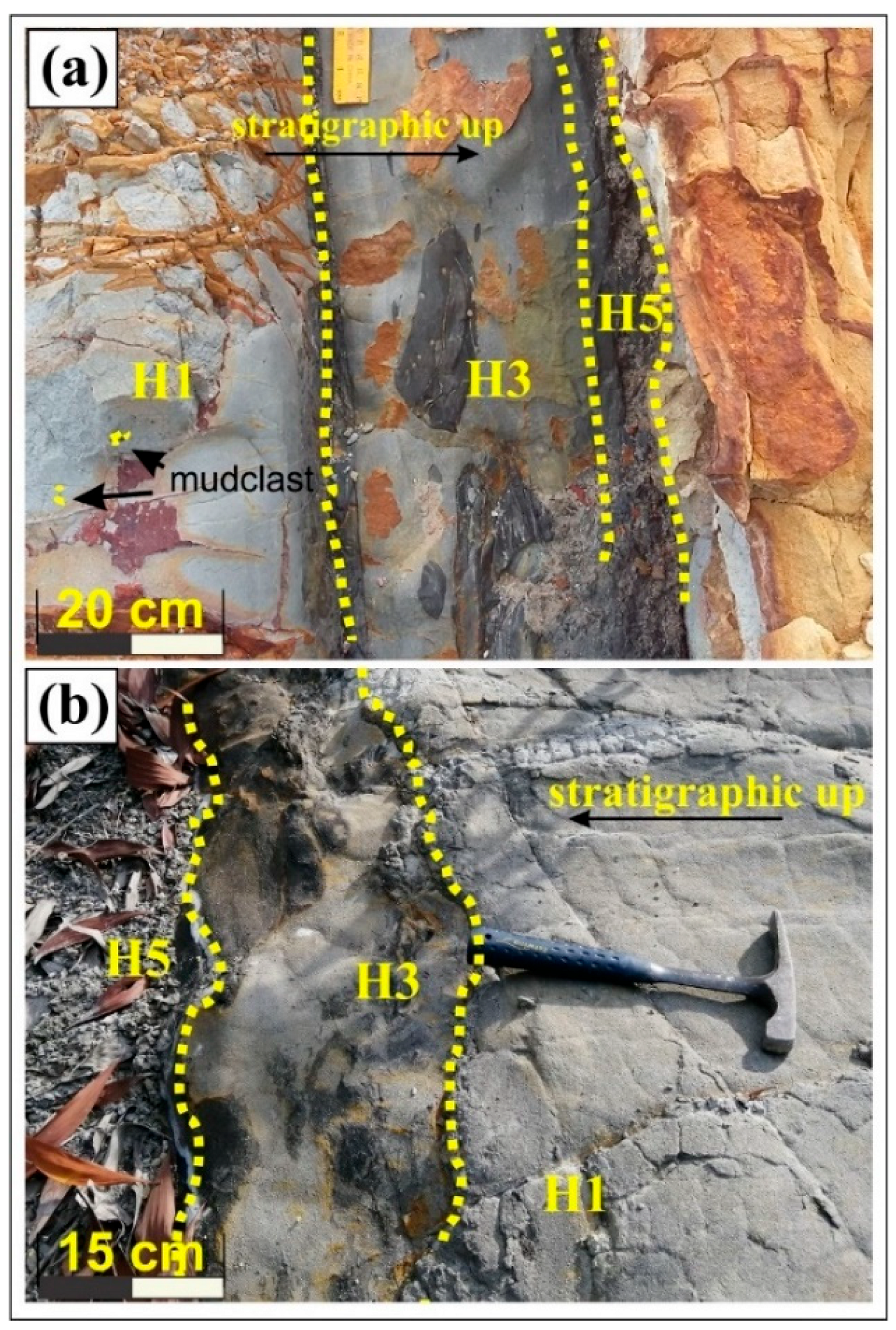
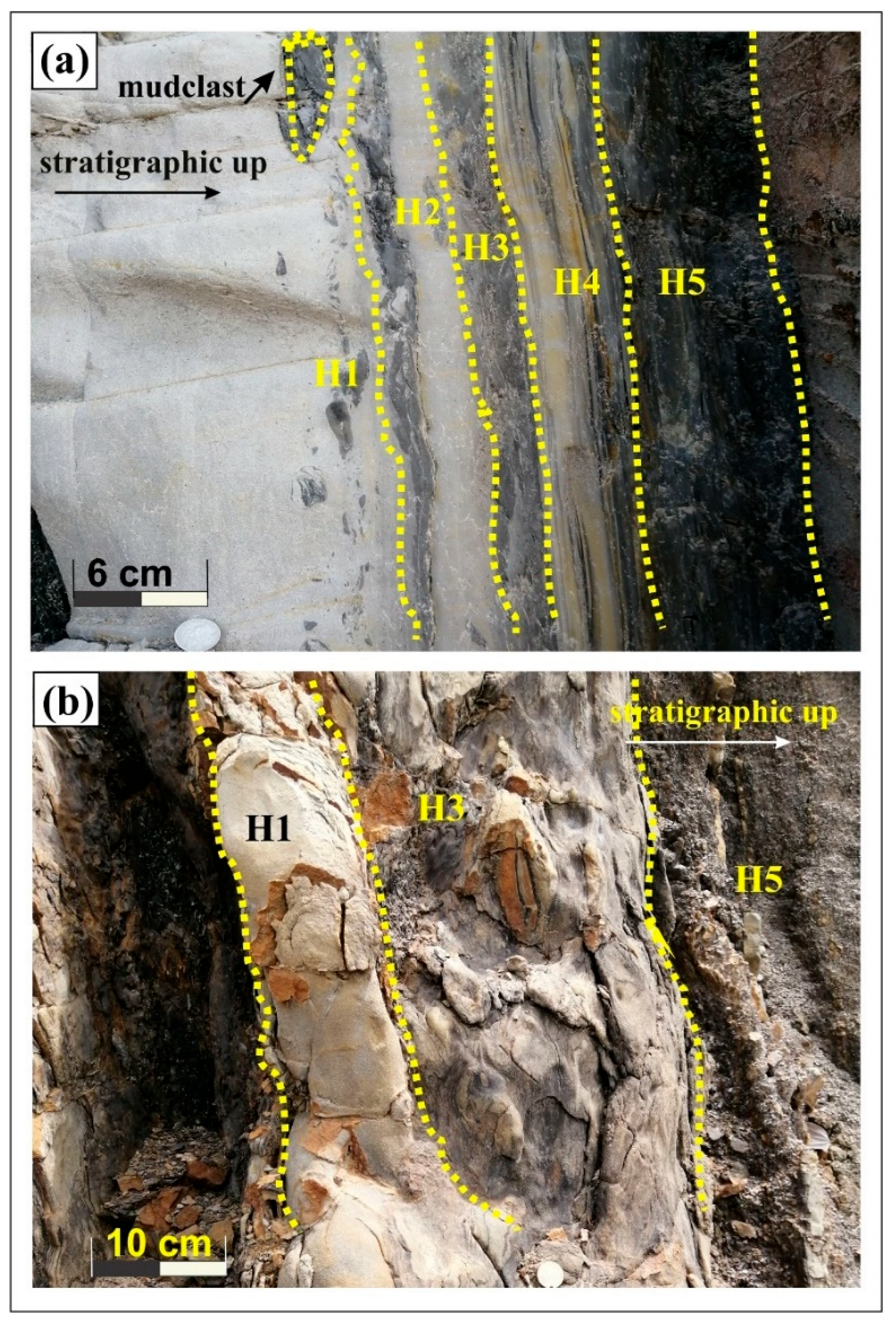
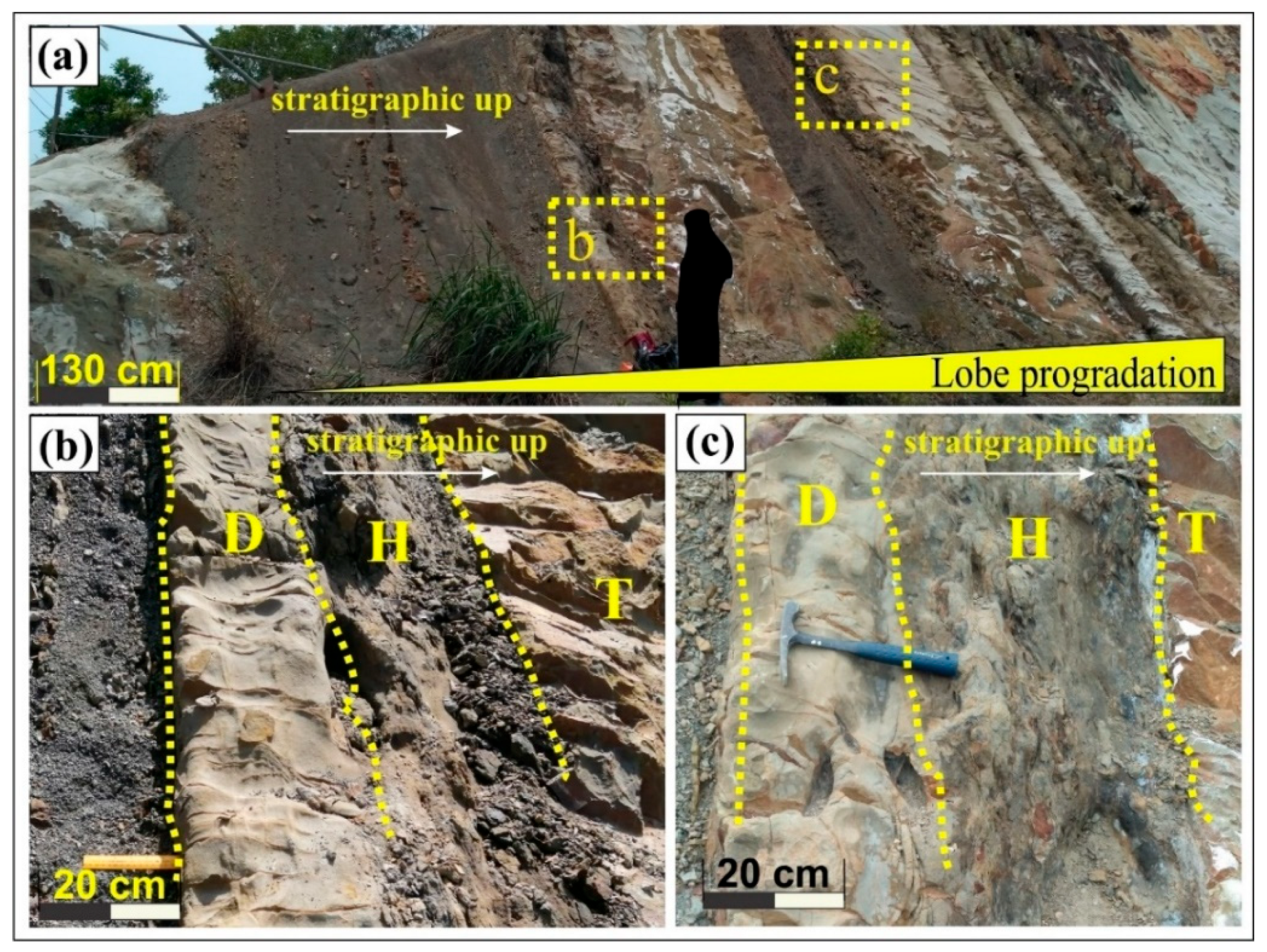
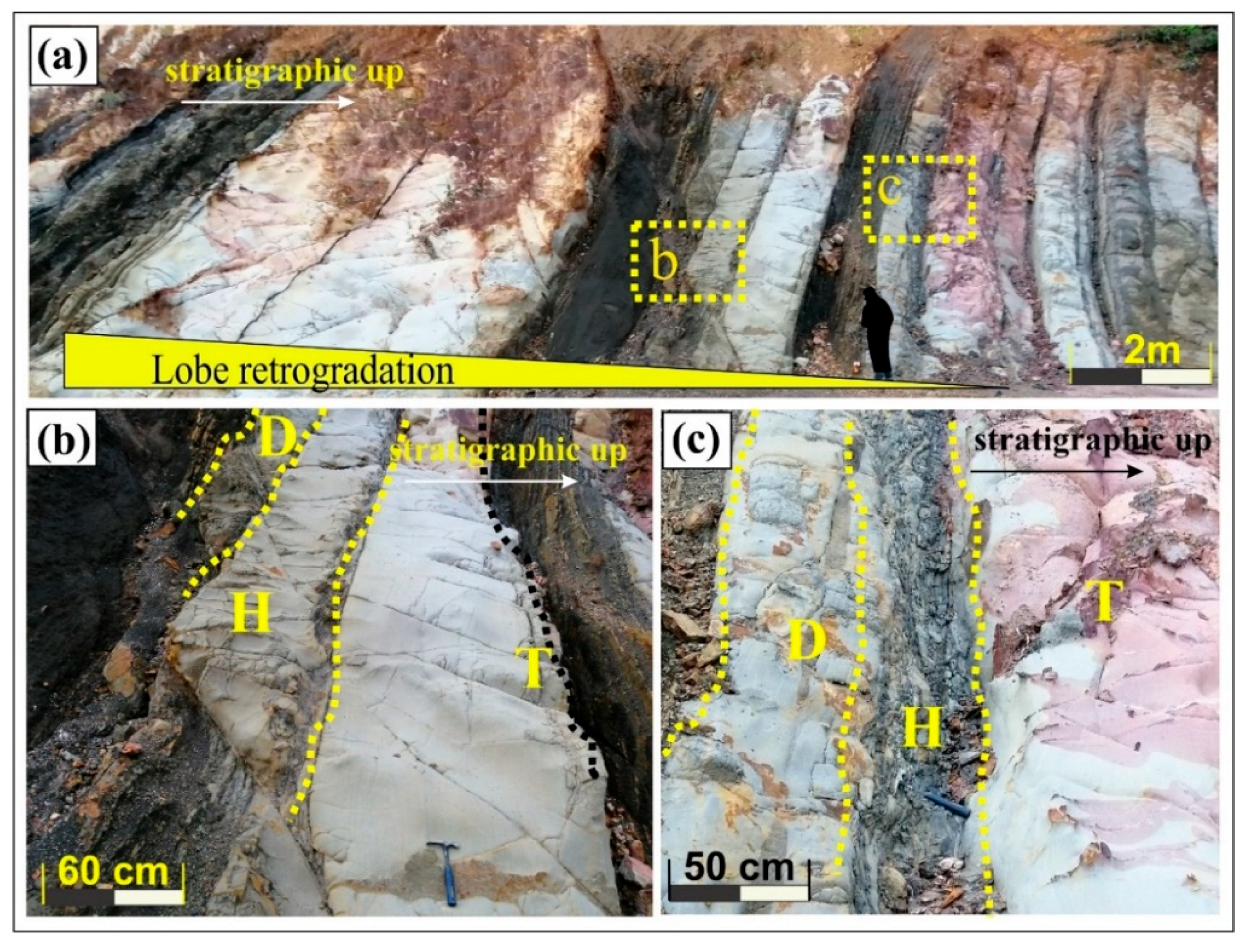
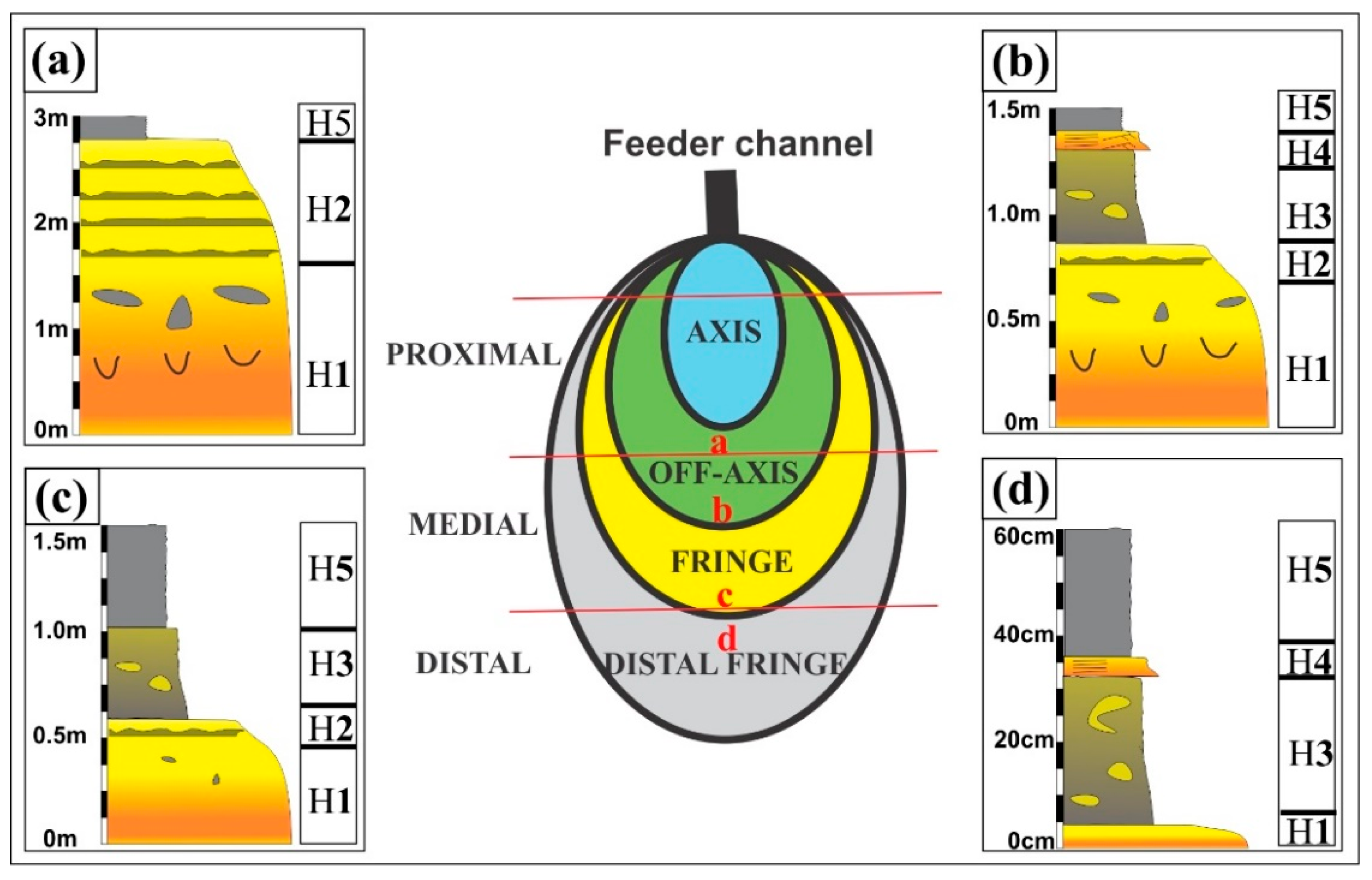
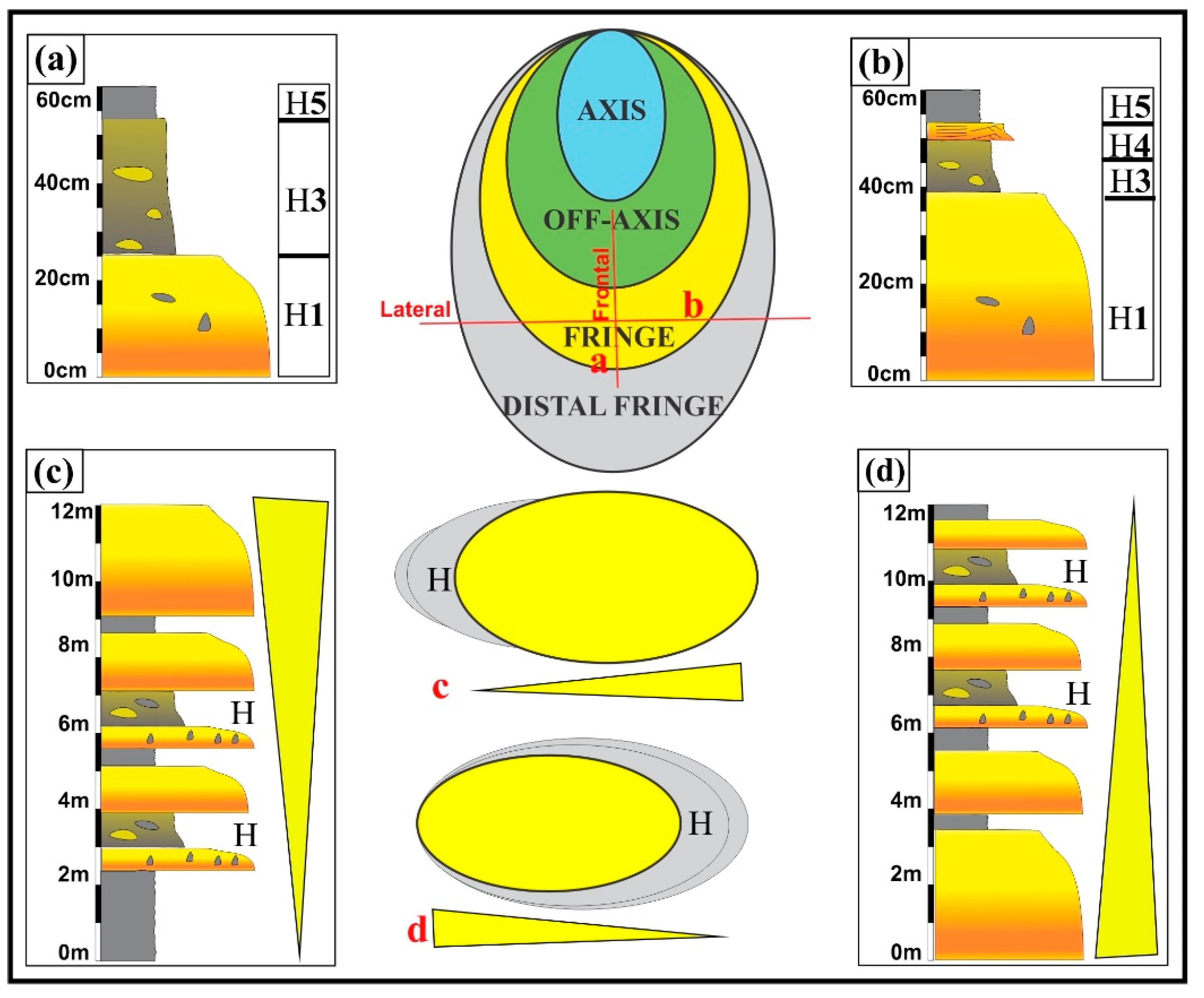
| No. | Abbreviation | Location Name | Region | Hybrid Beds Distribution |
|---|---|---|---|---|
| 1 | SUL | Jalan Sulaman | NW Sabah | Lateral lobe with complete hybrid facies |
| 2 | LPS | Lapasan | Distal lobe with all hybrid facies except H2Frontal lobe with mainly H1 and H3 hybrid facies | |
| 3 | PQ | Perwira Quarry | No hybrid beds, sandstones, and shale beds | |
| 4 | UU | University Utama, Telipok | No hybrid facies, mainly massive sandstones | |
| 5 | SP | Sepangger port bypass | Frontal lobes with H1 and H3 hybrid facies mainly | |
| 6 | UP | University Prima Condo | W Sabah | Lobe progradation with hybrid beds |
| 7 | JK | Jalan UMS behind the KFC | Medial lobes with complete set of hybrid faciesLobe retrogradation with hybrid beds | |
| 8 | JU | Jalan UMS roadside | Proximal lobe with hybrid beds H1, H2, and H5Lateral lobe with H1, H3, and H5 hybrid facies | |
| 9 | JBN | Jalan Bantayan | No hybrid beds sandstone and shale intervals | |
| 10 | KM | Kampung Madpai | No hybrid beds, mainly massive sandstones | |
| 11 | SUK | Kampung Sukang | No hybrid beds, thick to massive sandstone | |
| 12 | JLK | Jalan Lok Kawi Pengalat | SW Sabah | No hybrid beds, massive sandstones |
| 13 | MK | Kampung Mook | No hybrid beds, massive sandstones, and shales | |
| 14 | LKW | Lok Kawi wildlife | Distal lobe with hybrid facies H1, H3, and H5 | |
| 15 | KW | Kampung Kawang | No hybrid beds, mainly massive shale intervals | |
| 16 | PUR | Kampung Purak | No hybrid beds, mainly turbidites only | |
| 17 | BQ | Benoni Quarry | No hybrid beds, only debrites and turbidites |
Publisher’s Note: MDPI stays neutral with regard to jurisdictional claims in published maps and institutional affiliations. |
© 2021 by the authors. Licensee MDPI, Basel, Switzerland. This article is an open access article distributed under the terms and conditions of the Creative Commons Attribution (CC BY) license (https://creativecommons.org/licenses/by/4.0/).
Share and Cite
Jamil, M.; Siddiqui, N.A.; Ahmed, N.; Usman, M.; Umar, M.; Rahim, H.u.; Imran, Q.S. Facies Analysis and Sedimentary Architecture of Hybrid Event Beds in Submarine Lobes: Insights from the Crocker Fan, NW Borneo, Malaysia. J. Mar. Sci. Eng. 2021, 9, 1133. https://doi.org/10.3390/jmse9101133
Jamil M, Siddiqui NA, Ahmed N, Usman M, Umar M, Rahim Hu, Imran QS. Facies Analysis and Sedimentary Architecture of Hybrid Event Beds in Submarine Lobes: Insights from the Crocker Fan, NW Borneo, Malaysia. Journal of Marine Science and Engineering. 2021; 9(10):1133. https://doi.org/10.3390/jmse9101133
Chicago/Turabian StyleJamil, Muhammad, Numair Ahmed Siddiqui, Nisar Ahmed, Muhammad Usman, Muhammad Umar, Hamad ur Rahim, and Qazi Sohail Imran. 2021. "Facies Analysis and Sedimentary Architecture of Hybrid Event Beds in Submarine Lobes: Insights from the Crocker Fan, NW Borneo, Malaysia" Journal of Marine Science and Engineering 9, no. 10: 1133. https://doi.org/10.3390/jmse9101133
APA StyleJamil, M., Siddiqui, N. A., Ahmed, N., Usman, M., Umar, M., Rahim, H. u., & Imran, Q. S. (2021). Facies Analysis and Sedimentary Architecture of Hybrid Event Beds in Submarine Lobes: Insights from the Crocker Fan, NW Borneo, Malaysia. Journal of Marine Science and Engineering, 9(10), 1133. https://doi.org/10.3390/jmse9101133








